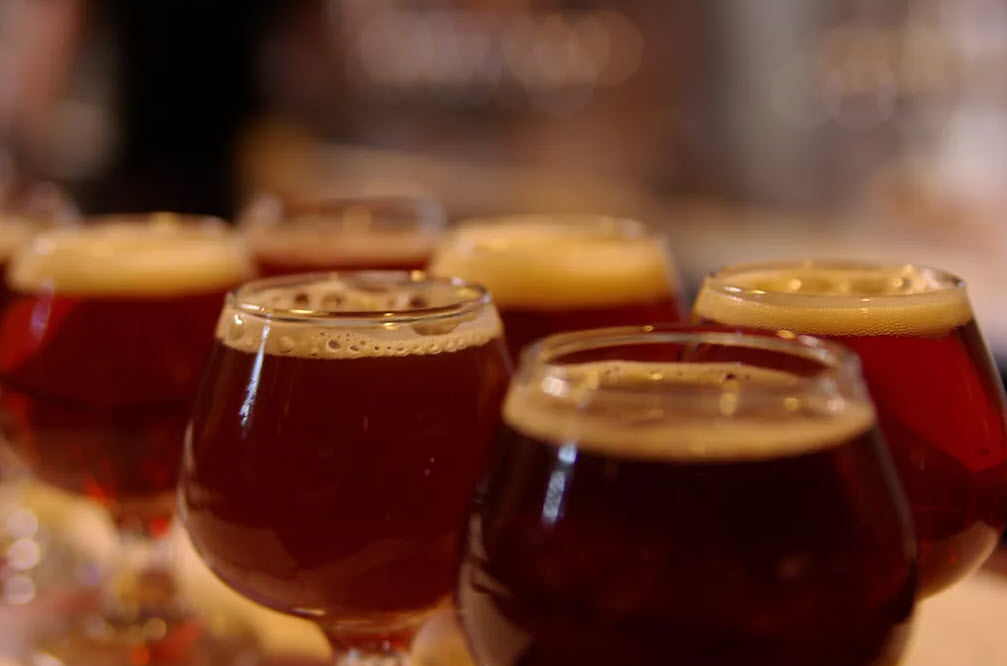Although they seem to have dropped in popularity recently (with the rise of craft brewers making ‘Imperial’ or ‘Double’ versions of almost every style now), for us barleywines are still one of the kings of beers. They are the beer world’s equivalent of the single malt whisky or vintage wine. A bigger, more potent, malty, powerhouse of a beer, they were the original ‘turn it to eleven’ style and definitely still deserve a lot of love.
As a style, however ‘barleywine’ remains a little undefined. The roots of the style appear to have come from a time when partiglye brewing was the norm – that is, making a batch of beer and using the first runnings to create a strong, high ABV beer and then sparging again to create a second and even third, smaller, ‘table’ beer. With the advent of the hydrometer, brewers were able to calculate the ABV of their beers which in turn led to them being taxed based on the strength of the beer they were producing. This led to a decline in popularity amongst these strong ales and a move towards more ‘sessionable’ brews.
As style definitions started to become more prominent, barleywine has not been helped by the fact it has a lot of similarities to old ales and imperial IPA’s and that it is also split into both American and British variations. Also, despite there being a clear ABV range defined by the BJCP, we see commercial beers called barleywines that fall outside of this scale on both sides. Barleywine has become synonymous with ‘strong’ beer and has then been outcompeted by Imperial IPA’s which play on people’s love for anything IPA.
As a brewer though a really good barleywine tests a lot of elements of your brewing process. Getting a reasonable efficiency for a beer that requires so much malt can be tricky and when making a beer where the malt character is a key component it can be tempting to try and include all kinds of weird and wonderful specialty malts. Truly great barleywines however can be made with nothing more than pale malt.
Oxygenating your wort will be of vital importance, as will proper pitching rates and creating a healthy yeast starter. Then fermentation brings its own set of issues. Getting decent attenuation in a beer of this strength can be difficult, as can finding a yeast that will cope in such a high gravity wort. Yeast selection will be extremely important as ester formation in the American version is not a big part of the style so you need a yeast that can ferment high gravity without becoming stressed and producing high amounts of flavour compounds. In British Barley Wines, some fruit esters are acceptable. If you are making a darker barleywine these should be towards the dark fruit end of the spectrum whereas pale Barley Wines should have lighter esters when present.
Barleywines require a lot of malt which takes up a lot of space in any system. Most people will probably find it easier to brew a smaller volume if you are looking to make this style from grain only. You could also partigyle or reiterated mash, use malt extract to help reach your gravity or boil your wort for longer to create a more concentrated wort (or any combination of these techniques). As mentioned above, a great barleywine can be made with just a flavourful base malt such as Maris Otter but you may choose to include Vienna, Munich or a small amount of cara/crystal malts to add some more malt complexity. There really is no need to do anything too complicated with the recipe though, you should be using such a high proportion of malt that you won’t risk lacking malt character regardless.
For your hop additions, this is predominantly what defines either a British or American version of the style (there are some other differences but hop choice is the big one!). If you are brewing a British Barley Wine then go with traditional British hops – think Fuggles or East Kent Goldings. IBU wise you are looking for between 35 and 70 depending on the start gravity of your wort but make sure you consider balance – your BU:GU should be around 0.52 for this style. For an American Barleywine anything between 50 – 100 IBU’s is acceptable and the BU:GU balance should be closer to 0.8-0.9.
As for your hop choices for the American variety the guidelines accept anything citrusy, fruity or New World so don’t feel restricted in your choices here but classic American hops (the three C’s and Amarillo for example) work well. Even though the hop character in the American variety is more assertive but there should still be a rich malt character.
Here’s our recipe for a classic American style barleywine with some tips on how to mash in effectively for a beer of this size;
Bigmouth Strikes Again (https://community.grainfather.com/recipes/16379)
So there are our tips for brewing a barleywine. They are big beers and as with all big beers they come with their own unique challenges but brewing the style well is always rewarding. Have you tried brewing a barleywine before? How did it go? What would you change? Let us know in the comments below or by emailing [email protected]
